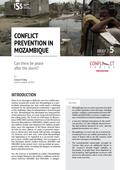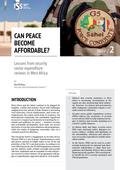You are here
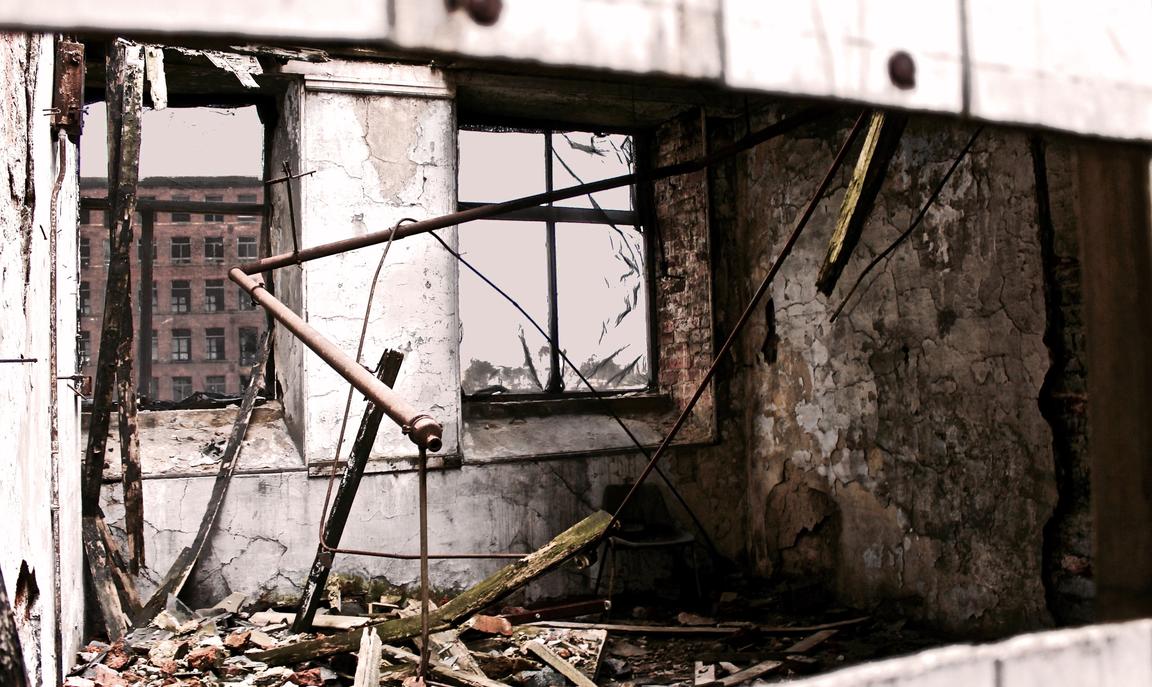
Iceberg ahead! Rethinking conflict prevention
Introduction
The costs of violent conflict are high and keep rising.1 The most visible cost is human life and health: the number of civilians dying directly from conflict doubled between 2005 and 2016 and the number of forcibly displaced persons increased fivefold between 2010 and 2016.2 While numbers are down again in 2017 (they stood at 90,000 direct deaths as a result of civil wars, a 31% decrease compared to 2014), they are still high in absolute numbers: 560,000 dead in Syria since the beginning of the war, more than 200,000 dead in Iraq since the invasion of 2003, and 60,000 dead in Yemen. And the list goes on: 19,000 in Afghanistan and 2,000 in both the Democratic Republic of the Congo (DRC) and Nigeria last year alone.3 Even larger is the number of victims dying indirectly from conflict; due to preventable infectious diseases, malnutrition, and neonatal- and pregnancy-related conditions which result from the conflict context, for instance. It is estimated that for every direct war victim, between 3 and 15 more die indirectly without ever appearing in conflict death statistics.4
Conflict does not just kill people, it also hurts economies. The Israeli-Palestinian conflict, for example, is estimated to have cost more than $12 trillion so far,5 while the destruction in Syria has by some estimates amounted to $388 billion (other aspects, such as environmental damage or indirect deaths from conflict are not included in this calculation). And conflict has other economic costs: people fleeing war lose most of their assets, while economic activity is stifled and financial capital leaves the country.6 In fact, the average annual loss of local GDP per capita due to conflict stands at 17.5%.7
Some of this cost also affects the international community: in 2018, more than 135 million people were in need of humanitarian assistance and protection, predominantly due to conflict. Moreover, the number of people receiving emergency aid has risen systematically in the past 10 years, from 28 million in 2008 to 97.9 million in 2018. While humanitarian agencies try to provide faster, more efficient and effective responses, the gap between the financial requirements and funds available has widened: in 2008, requirements amounted to $6.3 billion, with $5.2 billion funded; in 2018, requirements were $25.2 billion, with ‘only’ $15.1 billion funded.8 Simply put, humanitarian assistance is more costly than prevention.
While all of this should be reason alone to reconsider conflict prevention as a tool, there is another point in its favour: preventing conflict is actually cheaper than conflict itself. For each dollar invested in prevention, about $16 can be saved down the road,9 which means that conflict prevention could save anywhere between $5 and $70 billion a year.10
As the Secretary General of the United Nations Antonio Guterres pointed out in his first speech in office in 2017, “We spend far more time and resources responding to crises rather than preventing them. People are paying too high a price (…) We need a whole new approach”.11
A short history of conflict prevention
Conflict prevention, understood in simple terms as the action of stopping conflict from happening or arising, is as old as diplomacy. Since the origins of modern diplomacy, dating back to the Italian Renaissance, diffusing tensions and preventing the emergence of conflict has been one of the core functions of embassies. For instance, the signature of the Treaty of Lodi and the establishment of the Italic League in 1454 marked the end of a long phase of instability and warfare on the Italian peninsula, with a system of permanent embassies working to maintain peaceful relations between states and avoid relapsing into war.
Conflict prevention became a dominant theme at the Congress of Vienna in 1815, which put into effect a number of measures such as mutual consultations, the establishment of neutral states and demilitarized zones and the peaceful settlement of conflicts. Throughout the 19th century and the first half of the 20th century, multiple efforts were made by great powers to prevent conflict through collective diplomacy. In the 20th century, the League of Nations was established to prevent wars through collective security and disarmament. Its successor, the United Nations, states in its Charter that the goal of the organisation is ‘to take effective collective measures for the prevention and removal of threats to peace...’.12 Indeed, the European Union is itself a conflict prevention project.13
For each dollar invested in prevention, about $16 can be saved down the road,which means that conflict prevention could save anywhere between $5 and $70 billion a year.
However, it was not until the 1960s that conflict prevention started to become an independent and institutionalised policy field. UN Secretary General Hammarskjöld has been credited for being the first to formally coin “preventive diplomacy” in 1960,14 using it to describe efforts to contain conflicts from spreading. Since then, the concept has further evolved in academia and policymaking, initially through the scholarships on positive15 and liberal peace16, and research emphasising the types of conflict to be prevented (structural, violent, frozen etc).17 In the 1990s, UN Secretary General Boutros Boutros-Ghali extended Hammarskjöld's term in an upstream direction to mean not simply keeping regional conflicts from going global, but from starting in the first place.18 This conceptual breakthrough shifted the moment for taking action back to stages when non-violent disputes were emerging but had not escalated into significant violence or armed conflict.19 In 2001, his successor, Kofi Annan, released the report Prevention of Armed Conflict, calling for conflict prevention to become the cornerstone of collective security in the twenty-first century. However, subsequent wars and failed attempts at prevention discredited the idea as ineffective in the decade thereafter.
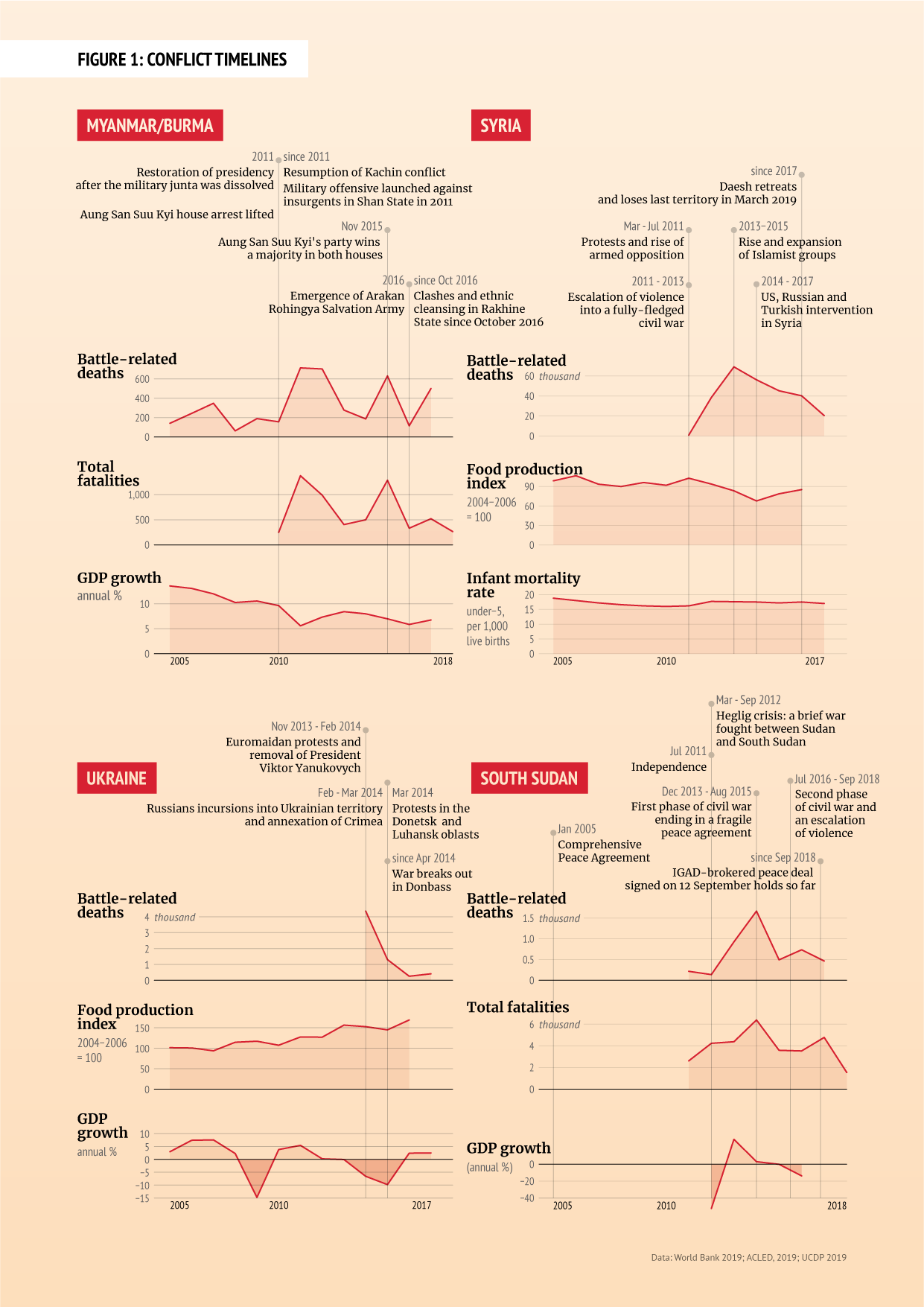
Precisely due to the prevalence of conflict, the concept has now reappeared for international policymakers. In 2017, the United Nations and the World Bank promoted a shift from managing and responding to crises towards preventing conflict in order to save lives and reduce costs.20 Such a renewed focus on prevention is now taking centre stage in international peacebuilding. How is this momentum different from the past?
Figure 2: Successful conflict prevention cases
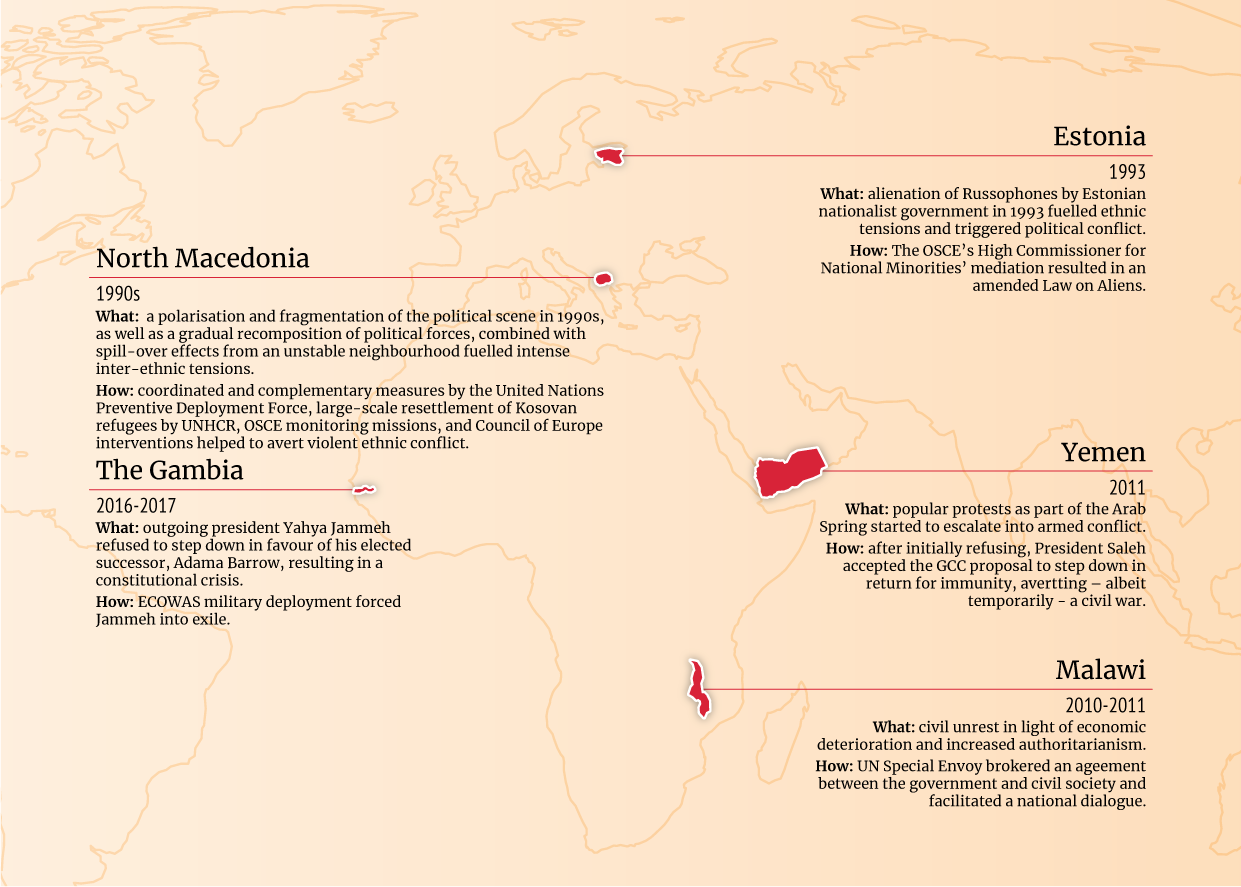
Data: Natural Earth, 2019
The concept of conflict prevention
Although the idea of conflict prevention sounds simple, its implementation is much more complex. For instance, the concept refers not solely to conflicts whose outbreak should be avoided, but also preventing relapse in a post-conflict society. Since internal conflicts last on average 5-10 years, and the risk of relapse is particularly high in the first decade after a conflict ends, prevention therefore benefits a country and its neighbourhood for 20-30 years. This means that prevention appears at several instances in the conflict cycle, with different approaches and mechanisms. It is for this reason that traditionally there was a distinction between direct/operational and structural conflict prevention.21
Operational conflict prevention relates to actions designed to address the immediate causes of conflicts, normally taken during the escalation phase of a given conflict where proximate, dynamic factors come into play. This conceptualisation of operational conflict prevention includes, among others, early warning and early response, preventive diplomacy, economic measures, and the use of force and aim at actors in manifest conflicts.
Structural prevention aims to reduce the likelihood of conflict and violence with positive incentives for societies that strengthen their resilience and provide access to political, economic, social and cultural opportunities. Structural issues often relate to issues such as political inclusivity, the development of justice systems, public administration, governance and economic development. This type of prevention works best in the very early stages of a conflict. But no matter at what stage, conflict prevention essentially seeks to make societies resilient to violent conflict by strengthening the capacities for peace. These can include a range of tools, from resolution systems to resources to structures, attitudes, and skills. Further work has introduced new and sometimes competing conceptual variants of prevention. The Berghof Foundation, for instance, focuses on four pillars of conflict prevention: ‘identifying situations that could result in violence, reducing manifests tensions, preventing existing tensions from escalating and removing sources of danger before violence occurs’.22 According to the Foundation, conflict prevention strategies ‘are defined by their goals and the stage of conflict when they are implemented.’23
These approaches do not simplify the prevention debate. But they can prove helpful to compare the different understandings, methodologies and instruments that international actors have developed over conflict prevention (see Figure 3 for an overview of four main multilateral organisations), helping to clarify where they stand in its implementation. For instance, the EU’s Horizon 2020-funded project ‘Improving EU capabilities for conflict prevention and peacebuilding’ (EU-CIVCAP)24 discerned three capabilities that, together, enable a multinational organisation to act as a pivot for conflict prevention. These are the capabilities to engage (institutions, instruments, personnel, and analysis), capabilities to fund (short and long-term), and to coordinate and cooperate within and with third parties.25
Figure 3: Conflict prevention in multilateral organisations
United Nations. The General Assembly and Security Council resolutions adopted in 2016 (A/70/262 and S/2282, respectively) on ‘sustaining peace’, encompass activities to ‘prevent the outbreak, escalation, continuation and recurrence of conflict, addressing root causes, assisting parties to conflict to end hostilities, ensuring national reconciliation and moving towards recovery, reconstruction and development’.
World Bank. According to the 2017 Pathways for Peace Report, the prevention challenge goes well beyond conflict, ‘encompassing all manner of avoidable artificial and natural crises that cause significant human suffering and undermine development’.
European Union. The Council of the European Union declared in 2011 that ‘preventing conflicts and relapses into conflict, in accordance with international low, is a primary objective of the EU’s external action, in which it could take a leading role in conjunction with its global, regional, national and local partners’.
African Union. As a policy priority, conflict prevention as a theme features widely in the Protocol Relating to the Establishment of the African Union’s Peace and Security Council (PSC): as a principle of early response to contain crisis situations so as to prevent them from developing into full-blown conflicts (Article 4b); as a power to anticipate and prevent disputes and conflicts, as well as policies that may lead to genocide and crimes against humanity (Article 7-1a); as a function of early warning and preventing diplomacy (Article 4c); and as an objective to anticipate and prevent conflicts, as in circumstances where conflicts have occurred, the Peace and Security Council shall have the responsibility to undertake peace-making and peacebuilding functions for the resolution of these conflicts (Article 3b).
NATO. The Alliance’s 2016 call for Projection Stability aims at preventing instability in areas of interest, and proposes a range of measures to achieve this chiefly in the area of partner capacity building.
Overall, conflict prevention has evolved over time, and has been subject to different phases of popularity, fatigue, and comeback. It most recently came to the fore and regained policy attention as a result of UN Secretary-General Antonio Guterres’ political leadership and commitment to a greater focus on prevention,26 within the framework of the UN reform process and through the 2017 UN-World Bank Pathways for Peace Report.
So, where do we stand today, and how is policy emphasis in 2019 different from the 1960s, or the Renaissance? Simply put, although conflict prevention appears to have stalled, it has evolved significantly since it was first conceptualised. Systems for early warning and early action are a case in point. Early warning is in fact a fundamental component of today’s conflict prevention policies, providing actors with the capabilities required to promptly identify risks of emergence, re-emergence or escalation of violence, and swiftly adapting policy responses so as to mitigate conflict risks. Without early warning, actors would not have a sufficient degree of awareness, nor the information needed to switch their actions towards more targeted prevention objectives. Today’s recognition of prevention as a high policy priority should therefore not be seen as a new mantra, but as form of a momentum to make prevention machines more effective and sophisticated, as well as capable of responding to evolving and more complex challenges based on new modalities of action. A quick review of past practices may be helpful to better understand what did not work in the past and how to improve it in the future.
Four practices of conflict prevention
Although practices of conflict prevention are manifold and multi-faceted, four came to the forefront of international politics since the 1990s: (1) prevention through mediation; (2) prevention through military peacekeeping and stabilisation; (3) prevention as preventive war (the ‘Bush doctrine’ in the United States); (4) prevention through early warning and early action.
Mediation is ‘the process whereby a third party assists two or more parties, with their consent, to prevent, manage or resolve a conflict by helping developing mutually acceptable agreements’.27 Since all mediation arguably has a preventive aim, its use as a technique to prevent different types of violent conflict has been increasingly popular. The frequency and the likelihood of mediation attempts has increased substantially since the end of the Cold War: since then, 73% of civil wars saw mediation attempts – in comparison to 24% of Cold War-era civil wars.28 Furthermore, over the period 1989-2014, 24% of armed conflicts benefitted from the engagement of a formal third-party negotiator.29 As many attempts – such as in Nicaragua, Angola, Namibia, El Salvador, Timor-Leste and Mozambique – appeared successful, this approach has remained in place and is still considered as a mainstream preventive practice today. But it has not been successful throughout, with some important challenges and limitations such as the difficult collaboration between high-level preventive diplomacy and local peacemaking mechanisms, or the risks emanating from contacts with extremist groups.
Since its inception, peacekeeping has contributed to preventing and managing violent conflict between and within states. Traditional peacekeeping can in fact be considered a conflict-prevention tool, as it was designed to de-escalate conflicts or oversee the implementation of ceasefires to prevent the relapse of countries emerging from conflict. In many cases, peacekeeping troops were used preventively to forestall violence.30 The evolving dynamics of conflicts have, however, expanded peacekeeping from its original mitigation role to broader and more robust mandates, including stronger support to political processes and the rule of law. In the UN system, the gap between military peacekeeping versus conflict prevention/peacebuilding instruments has grown continuously: UN instruments for conflict prevention, such as the Peacebuilding Fund or the Department of Political Affairs, represent only a small fraction of the overall peacekeeping budget.31 As a matter of fact, for a long time military peacekeeping was seen as the primary and most-effective tool to address conflict, including preventing it. The numbers support this logic: the more robust a UN peacekeeping mandate is and the higher its funding, the more likely it is to contribute to post-conflict recovery and prevent relapse into conflict. It has been also shown that had the UN doubled its peacekeeping operations budget, the propensity of major armed conflict would have been more than halved.32 Another study concluded that the presence of peacekeeping troops results in a drop of conflict relapse rates by 75-85%.33
Mainstream practices of conflict prevention today are essentially an integrated approach, whereby the military/security dimension is only a small component of a wider array of instruments.
Despite this evidence, the military dimension of conflict prevention has been discredited by high levels of violence in the 200os, and in particular by the implications and failure of the preventive war doctrine used by the George W. Bush administration for military interventions in Afghanistan (2001) and Iraq (2003). Preventive wars can be seen as the most dangerous and radical drift in the attempt by the international community to resort to the use of military means for prevention purposes. The disastrous consequences in Afghanistan and Iraq had the long-term implications of making military engagements and stabilisation approaches a taboo, especially in Western democracies.
Against this background, the current practices of prevention have switched towards an emphasis on the comprehensive and institutionalised assessment of the root causes of a conflict when the crisis it is still at an early stage, and hence it is still possible to change course – this is the underlying logic of early warning systems (EWS); and move us on to on the political, technical and financial incentives and measures to turn the warning into action, integrating diplomatic, development, security and humanitarian interventions. Mainstream practices of conflict prevention today are essentially an integrated approach, whereby the military/security dimension is only a small component of a wider array of instruments.
There have also been technological advances that have opened up new frontiers in conflict prevention – though it would premature to talk of a ‘breakthrough’. The use of data for strategic foresight is a case in point. One study, for instance, claims to be able to predict half of all conflicts up to eight years in advance.34 In this calculation, there was a high correlation between conflict onsets and the following: having experienced a conflict in the ten years prior (half of countries that have experienced a conflict will relapse within this period), a location in a violent neighbourhood, population size (the larger, the more likely a conflict onset), low education levels, youth bulges, and high levels of infant mortality. Pakistan, Afghanistan, India, Sudan and Ethiopia will all be at risk of conflict in 2030, but the study also found high levels of conflict risk for Myanmar/Burma, Turkey and China. That said, this kind of conflict arithmetic has its limits for the time being, but large-scale databases such as Seshat have the potential to give us clues about the patterns and reasons for conflict.35
Fast forward: how to seize the day in conflict prevention
Looking forward, how can the renewed focus on conflict prevention be best supported, implemented and measured? A few key, yet non-exhaustive elements are outlined below.
Resources. Perhaps the most important measure to avoid conflict is also the most unpopular: increasing the financing of conflict prevention would give a significant boost to conflict reduction. But at the moment, international actors are still reactive rather than proactive when it comes to conflict, targeting symptoms rather than causes with their assistance according to a OECD report, which also stated that donors should invest in prevention as a way to save lives, resources, and money.36 According to the OECD, two parameters are crucial for lasting peace: low levels of conflict complexity and available resources – which themselves depended on whether a conflict affected the strategic interests of a great power.37
Behaviour. For most practitioners working on conflicts, pivoting to conflict prevention means stepping out of their comfort zone and learning a new way of working, thinking and acting more upstream. There is a human dimension of prevention, which entails trainings and programmes aimed at fostering behavioural change and creating a wider and more cohesive community of practice. Without sufficient investment in this process, through education and training, mindsets will not change and international actors run the risk of preaching the need for preventive actions in an overwhelmingly reactive arena.
Technology. Conflict prevention needs strategic enablers. Technology can serve this purpose and help usher in a new era for prevention, overcoming past challenges. An effective use of big data for shared analyses, for instance, can allow to predict future trends more accurately. Satellites and remotely piloted aircraft systems have also a potential to contribute to conflict prevention activities, namely intelligence, surveillance, border assistance, force and population protection, and other similar tasks.38 More generally, enhanced exploitation of dual-use technologies would provide significant and cost-effective benefits to prevention.39
Security. The role of the military in conflict prevention is essential. Future prevention is linked to the involvement of the military, and the value added provided by armed forces in terms of filling some gaps civilians struggle with. This includes, for instance, contributions in terms of available assets, information and intelligence sharing and conflict sensitivity.40 A truly integrated approach for prevention can only be achieved if the taboo of military deployment is overcome.
Narrative. A correct narrative to support prevention is of the utmost importance. This narrative should go beyond the ‘costs of conflict’ vs ‘savings from prevention’, and more explicitly help build coalitions for prevention. Perhaps most importantly, conflict prevention needs case studies. Practitioners need to better understand what worked, what did not work, what instruments for prevention are more effective in different phases of the conflict cycle and what are the lessons from different countries, regions and cultural contexts. Assuming the current momentum will continue, prevention will need to be tested in order to generate experiential learning. It is also important to explore new ideas and concepts that may improve prevention policies, pushing actors to think outside the box.
As part of its new series of Briefs on conflicts, the EUISS will promote a dedicated focus on country and thematic cases for prevention that deserve policy attention and help foster new ways thinking.
References
* With research assistance and contributions towards visuals by Ard Vogelsang (Trainee, EUISS).
1) Rob Smith, Conflict costs the global economy $14 trillion a year, World Economic Forum, January 15, 2018, https://www.weforum.org/agenda/2018/01/conflict-costs-global-economy-14-trillion-a-year/.
2) World Bank and United Nations, Pathways for Peace: Inclusive Approaches to Preventing Violent Conflict, 2018, p. v-vi.
3) Håvard Strand et al., "Fewer Lives Being Lost in Conflicts", PRIO, June 2018, https://blogs.prio.org/2018/06/fewer-lives-being-lost-in-conflicts/.
4) Geneva Declaration on Armed Violence and Development, "Global Burden of Armed Violence 2008, Chapter Two: The Many Victims of War: Indirect Conflict Deaths", http://www.genevadeclaration.org/measurability/global-burden-of-armed-violence/global-burden-of-armed-violence-2008.html.
5) Strategic Foresight Group, "Cost of Conflict in the Middle East", Mumbai 2009.
6) Anke Hoeffler, "Measuring the Costs of Conflict", March 2003, http://citeseerx.ist.psu.edu/viewdoc/download?doi=10.1.1.460.2979&rep=rep1&type=pdf.
7) Stefano Costalli et al., "The economic costs of civil war: Synthetic counterfactual evidence and the effects of ethnic fractionalization", Journal of Peace Research, vol. 54(1), 2017, pp. 80-98,
8) Global Humanitarian Overview 2018, http://interactive.unocha.org/publication/globalhumanitarianoverview/#ataglanceposition.
9) Institute for Economics and Peace, "Measuring Peacebuilding Cost-Effectiveness", 2017, http://visionofhumanity.org/app/uploads/2017/03/Measuring-Peacebuilding_WEB.pdf.
10) World Bank, "The Economic Cost of Conflict", April 2018, https://www.worldbank.org/en/news/infographic/2018/03/01/the-economic-cost-of-conflict.
11) See: https://news.un.org/en/story/2017/01/549122-security-council-un-chief-guterres-makes-case-new-efforts-build-and-sustain.
12) Article 1, paragraph 1 of the United Nations Charter, http://www.un.org/en/sections/un-charter/chapter-i/index.html.
13) See: Guy Banim and Eva Pejsova (eds), "Prevention better than cure: the EU’s quiet diplomacy in Asia", EUISS Report, no. 33, May 2017, p. 10.
14) Bertrand G. Ramcharan, “Preventive Diplomacy at the United Nations”, in UN Chronicle, vol. XLVIII, no.2, July 2011, https://unchronicle.un.org/article/preventive-diplomacy-united-nations.
15) John Galtung, “Violence, Peace and Peace Research”, Journal of Peace Research, 6:3, 1969, pp. 167-191.
16) Oliver Richmond, A post-liberal peace (London: Routledge, 2011).
17) For an overview of the different understandings of conflict prevention, see: Laura Davis, Nabila Habbida and Anna Penfrat, Report on the EU’s Capabilities for Conflict Prevention, EU-CIVCAP, Deliverable 3.2, January 30, 2017, pp. 9-10.
18) See: United Nations, An Agenda for Peace: Preventive diplomacy, peacemaking and peace-keeping: Report of the Secretary-General, 1992, https://www.un.org/ruleoflaw/files/A_47_277.pdf.
19) Michael Lund, “Conflict Prevention: Theory in pursuit of policy and practice”, in Jacob Bercovitch, Victor Kremenyuk, William Zartman (eds), The SAGE Handbook of Conflict Resolution, 2008, pp. 287-321.
20) Ibid., iii.
21) This distinction originates from the 1997 Carnegie Commission report on Preventing Deadly Conflict, https://www.carnegie.org/media/filer_public/b2/0e/b20e1080-7830-4f2b-9410-51c14171809b/ccny_report_1997_ccpdc_final.pdf.
22) Berghof Foundation, Berghof Glossary on Conflict Transformation: 20 notions for theory and practice, March 2012, p. 17.
23) Lawrence Woocher, Preventing Violent Conflict: Assessing Progress, Meeting Challenges, USIP Special Report 231, September 2009, p. 2.
24) See: https://eu-civcap.net/.
25) Davis et al., 2017, 167.
26) See: https://news.un.org/en/story/2018/06/1012462.
27) Guy Banim and Ingrid Magnusson, Low Road to Peace: The Potential of Peace Mediation on Revitalising Prevention, Input Paper for Federal Foreign Office Conference, “Preventing Violent Conflict – Operationalising Conflict Prevention”, Berlin, April 27, 2017, p.1.
28) Richard Gowan and Stephen John Stedman, ‘The International Regime for Treating Civil War, 1988 – 2017’, Daedalus, vol. 147, no. 3, winter 2018.
29) Banim and Magnusson (2017), p. 2.
30) See: Stuart J. Kaufman, “Preventive peacekeeping, ethnic violence, and Macedonia”. In Studies in Conflict and Terrorism, vol. 19, 1996, pp. 229-246.
31) See: Annette Leijenaar and Gustavo de Carvalho, We can honour UN peacekeepers by preventing conflicts, Institute for Security Studies, May 27, 2017.
32) Havard Hegre, "Evaluating the conflict-reducing effect of UN peacekeeping operations", May 2015, https://www.cega.berkeley.edu%2Fassets%2Fmiscellaneous_files%2F122_-_Hegre_Hultman_Nygard_-_PKO_prediction_2015_-_ABCA.pdf&usg=AOvVaw2nCXVw0obbiwiYnuSYRi6R.
33) Virginia Page Fortna, "Does Peacekeeping Keep Peace? International Intervention and the Duration of Peace After Civil War”, International Studies Quarterly, vol.48, 2004, pp. 269-292. Virginia Page Fortna, Does Peacekeeping Work?: Shaping Belligerents’ Choices After Civil War (Princeton: Princeton University Press, 2008).
34) Havard Hegre et al., "Prediciting Armed Conflict, 2010 – 2050", International Studies Quarterly, vol. 57, June 2013. Lars-Erik Cederman & Nils B. Weidmann, "Predicting armed conflict: Time to adjust our expectations?", Science, February 03, 2017, vol. 355, Issue 6324, pp. 474-476. Thomas Chadefaux, "Conflict forecasting and its limits", Data Science, no.1, 2017.
35) Chris Perry, "Machine Learning and Conflict Prediction: A Use Case’, International Journal of Security and Development, vol.2, no.3, June 2013.
36) OECD, "States of Fragility 2016: Understanding Violence", p. 7, http://www.oecd.org/dac/states-of-fragility-2016-9789264267213-en.htm.
37) George Downs & Stephen John Stedman, "Evaluation Issues in Peace Implementation", in Ending Civil Wars: The Implementation of Peace Agreements, ed. Stephen John Stedman et al., (Boulder: Lynne Rienner, 2002), pp.43-69.
38) See: Christian Barbieri, Jenny Berglund and Yannick Arnaud, Report on dual-use technologies, EU-CIVCAP, Preventing and Responding to Conflict: Developing EU CIVilian CAPabilities for a sustainable peace, Deliverable 2.4, January 30, 2018, p. 7.
39) Ibid., p. 8.
40) For more on the term, see: https://ec.europa.eu/europeaid/policies/fragility-and-crisis-management/analytical-tools_en.

